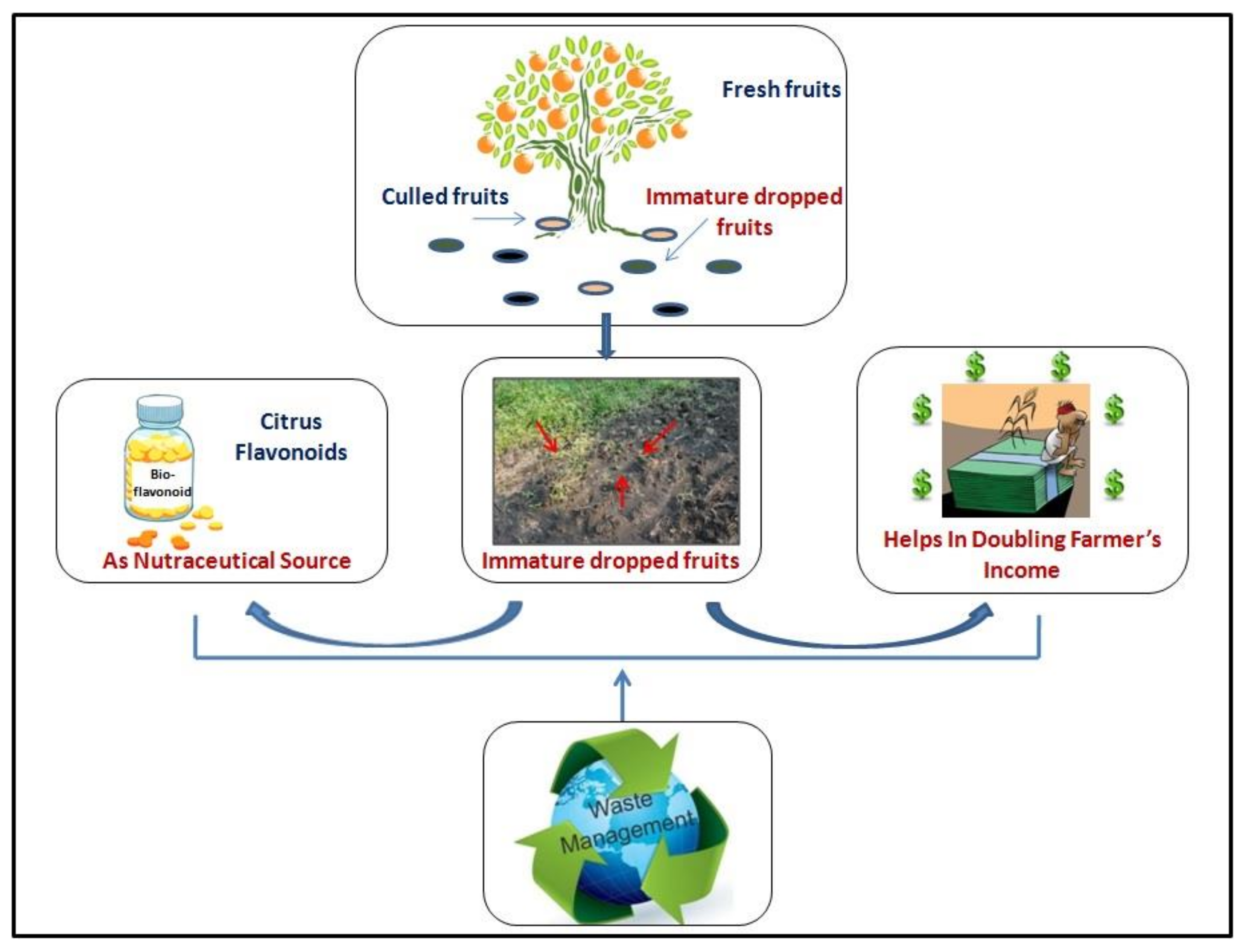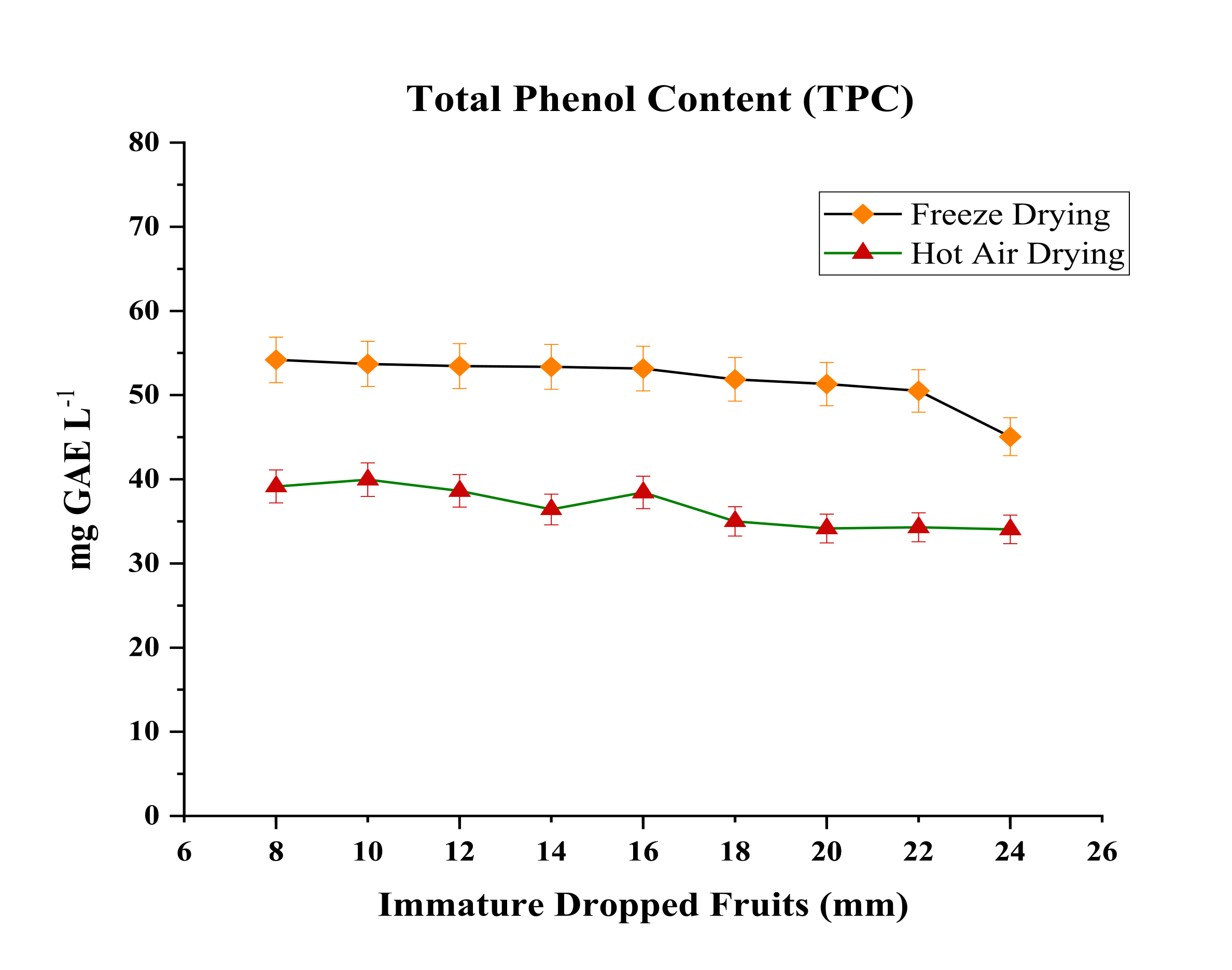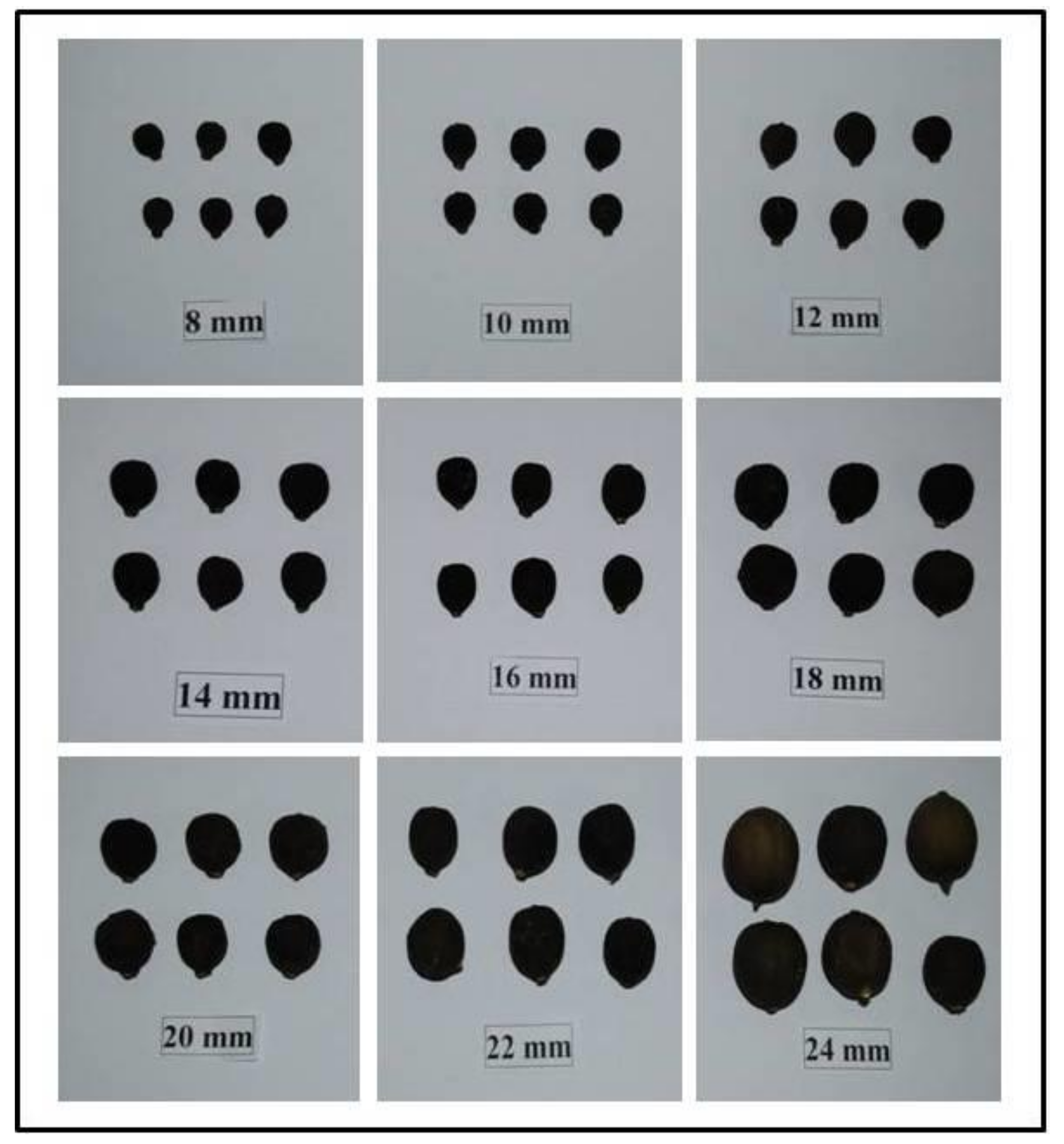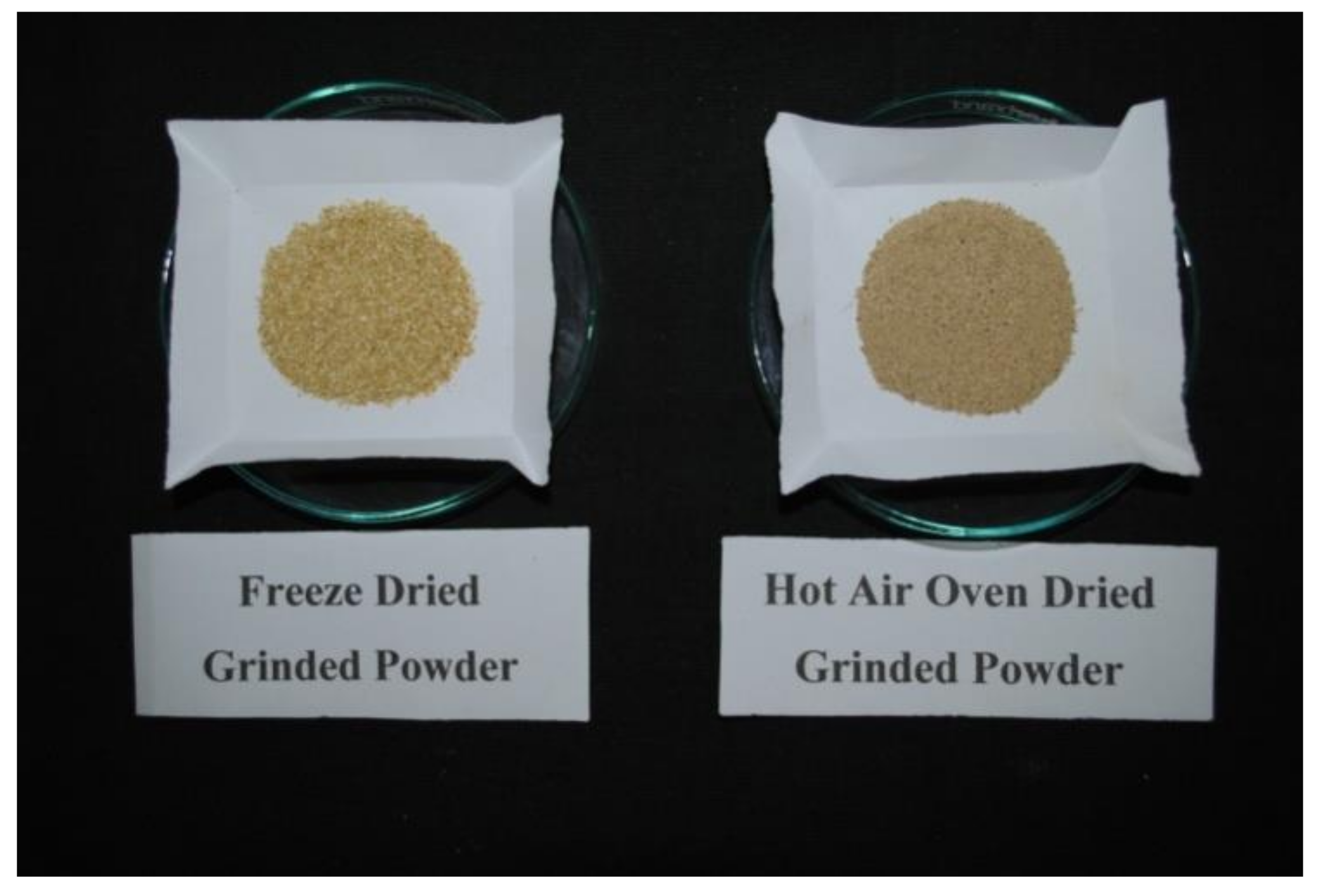Quantification of Flavonoids, Phenols and Antioxidant Potential from Dropped Citrus reticulata Blanco Fruits Influenced by Drying Techniques
Abstract
1. Introduction
2. Results and Discussion
2.1. Flavonoids Content
2.2. Antioxidant Activity
2.3. Total Phenol Content
2.4. Correlation Coefficients between Flavonoid Content, Antioxidant Activity and Total Phenol Content
3. Materials and Methods
3.1. Materials
3.2. Drying Techniques
3.3. Hot Air Oven Drying and Freeze Drying
3.4. Reagents and Standards
3.5. Sample and Standard Preparation
3.6. Flavonoid Quantification by High-Performance Liquid Chromatography (HPLC)
3.7. Antioxidant Activity
3.7.1. ABTS·+Radical Scavenging Assay
3.7.2. DPPH Radical Scavenging Assay
3.7.3. FRAP Assay
3.8. Total Phenol Content (TPC)
3.9. Statistical Analysis
4. Conclusions
Author Contributions
Funding
Data Availability Statement
Acknowledgments
Conflicts of Interest
Sample Availability
References
- Turner, T.; Burri, B.J. Potential Nutritional Benefits of Current Citrus Consumption. Agriculture 2013, 3, 170–187. [Google Scholar] [CrossRef]
- NHB Horticulture Database. 2018–2019. Available online: www.nhb.gov.in (accessed on 8 July 2020).
- Lv, X.; Zhao, S.; Ning, Z.; Zeng, H.; Shu, Y.; Tao, O.; Xiao, C.; Lu, C.; Liu, Y. Citrus fruits as a treasure trove of active natural metabolites that potentially provide benefits for human health. Chem. Cent. J. 2015, 9, 1–14. [Google Scholar] [CrossRef] [PubMed]
- Okwu, D.E. Citrus fruits: A rich source of phytochemicals and their roles in human health. Int. J. Chem. Sci. 2008, 6, 451–471. [Google Scholar]
- Sun, Y.; Shen, Y.; Liu, D.; Ye, X. Effects of drying methods on phytochemical compounds and antioxidant activity of physiologically dropped un-matured citrus fruits. LWT Food Sci. Technol. 2015, 60, 1269–1275. [Google Scholar] [CrossRef]
- Barreca, D.; Bellocco, E.; Caristi, C.; Leuzzi, U.; Gattuso, G. Flavonoid Composition and Antioxidant Activity of Juices from Chinotto (Citrus × myrtifolia Raf.) Fruits at Different Ripening Stages. J. Agric. Food Chem. 2010, 58, 3031–3036. [Google Scholar] [CrossRef] [PubMed]
- Inafuku-Teramoto, S.; Suwa, R.; Fukuzawa, Y.; Kawamitsu, Y. Polymethoxyflavones, Synephrine and Volatile Constitution of Peels of Citrus Fruit Grown in Okinawa. J. Jpn. Soc. Hortic. Sci. 2011, 80, 214–224. [Google Scholar] [CrossRef]
- Tripoli, E.; La Guardia, M.; Giammanco, S.; Di Majo, D.; Giammanco, M. Citrus flavonoids: Molecular structure, biological activity and nutritional properties: A review. Food Chem. 2007, 104, 466–479. [Google Scholar] [CrossRef]
- Leo, F.D.; Bosco, S.F.D. Citrus flavonoids as bioactive compounds: Role, bioavailability, socio-economic impact and biotechnological approach for their modification. In Proceedings of the 9th ICABR International Conference on Agricultural Biotechnology: Ten Years Later, Ravello, Italy, 6–10 July 2005. [Google Scholar]
- Omidbaigi, R.; Nasiri, M.F. Quantitive distribution of hesperidin in Citrus species, during fruit maturation and optimal harvest time. Nat. Prod. Radiance 2004, 3, 12–15. [Google Scholar]
- Rafiq, S.; Kaul, R.; Sofi, S.A.; Bashir, N.; Nazir, F.; Nayik, G.A. Citrus peel as a source of functional ingredient: A review. J. Saudi Soc. Agric. Sci. 2018, 17, 351–358. [Google Scholar] [CrossRef]
- Kumar, D.; Ladaniya, M.S.; Gurjar, M. Underutilized Citrus sp. Pomelo (Citrus grandis) and Kachai lemon (Citrus jambhiri) exhale in phytochemicals and antioxidant potential. J. Food Sci. Technol. 2019, 56, 217–223. [Google Scholar] [CrossRef]
- Gümüşay, Ö.A.; Borazan, A.A.; Ercal, N.; Demirkol, O. Drying effects on the antioxidant properties of tomatoes and ginger. Food Chem. 2015, 173, 156–162. [Google Scholar] [CrossRef]
- Gąsecka, M.; Siwulski, M.; Magdziak, Z.; Budzyńska, S.; Stuper-Szablewska, K.; Niedzielski, P.; Mleczek, M. The effect of drying temperature on bioactive compounds and antioxidant activity of Leccinum scabrum (Bull.) Gray and Hericium erinaceus (Bull.) Pers. J. Food Sci. Technol. 2020, 57, 513–525. [Google Scholar] [CrossRef]
- Kumar, D.; Ladaniya, M.S.; Gurjar, M.; Mendke, S.; Kumar, S. Hesperidin a major flavonoid with high antioxidant potential and nutraceutical source in dropped fruits of sweet orange (C. sinensis (L.) osbeck). Int. J. Innov. Hortic. 2020, 9, 39–45. [Google Scholar] [CrossRef]
- McClements, D.J. Nanoparticle- and Microparticle-Based Delivery Systems: Encapsulations, Protection and Release of Active Compounds; CRC Press: Boca Raton, FL, USA, 2015. [Google Scholar]
- Varzakas, T.; Zakynthinos, G.; Verpoort, F. Plant Food Residues as a Source of Nutraceuticals and Functional Foods. Foods 2016, 5, 88. [Google Scholar] [CrossRef]
- Li, R.; Shang, H.; Wu, H.; Wang, M.; Duan, M.; Yang, J. Thermal inactivation kinetics and effects of drying methods on the phenolic profile and antioxidant activities of chicory (Cichorium intybus L.) leaves. Sci. Rep. 2018, 8, 1–9. [Google Scholar] [CrossRef]
- Kim, J.H.; Kim, M.Y. Phytochemical and antioxidant characterization of thinned immature Citrus unshiu fruits. Int. J. Pharm. Pharm. Sci. 2017, 9, 293–297. [Google Scholar] [CrossRef][Green Version]
- Omidbaigi, R.; Nasiri, M.F.; Sadr, Z.B. Hesperidin in citrus species, quantitative distribution during fruit maturation and optimal harvesting time. Possibilities Limit. Med. Aromat. Plant 2002, 576, 91–97. [Google Scholar] [CrossRef]
- Ladaniya, M.S. Citrus Fruit: Biology, Technology and Evaluation; Academic Press: San Diego, CA, USA, 2008. [Google Scholar] [CrossRef]
- Ortuño, A.; Garcia-Puig, D.; Fuster, M.D.; Perez, M.L.; Sabater, F.; Porras, I.; Garcia-Lidon, A.; Del Rio, J.A. Flavanone and Nootkatone Levels in Different Varieties of Grapefruit and Pummelo. J. Agric. Food Chem. 1995, 43, 1–5. [Google Scholar] [CrossRef]
- Jourdan, P.S.; McIntosh, C.A.; Mansell, R.L. Naringin levels in citrus tissues: II. Quantitative distribution of naringin in Citrus paradise Macf. Plant Physiol. 1985, 77, 903–908. [Google Scholar] [CrossRef] [PubMed]
- Hasegawa, S.; Maeir, V.P. Some aspects of citrus biochemistry and juice quality. In Proceedings of the International Society of Citriculture, Tokyo, Japan, 9–12 November 1981; Volume 2, pp. 914–918. [Google Scholar]
- Del Rio, J.A.; Ortuno, A. Citrus paradise Macf (Grapefruit): In vitro culture and the bioproduction of sesquiterpenes nootkation, valencene and other secondary metabolites. In Biotechnology in Agriculture and Forestry; Medicinal and Aromatic plants VII; Springer: Berlin, Germany, 1994; Volume 28, pp. 123–138. [Google Scholar]
- Del Rio, J.A.; Fuster, M.D.; Sabater, F.; Porras, I.; Garcia-Lidon, A.; Ortuno, A. Effect of benzylaminopurine on the flavanones hesperidin, hesperetin 7-O-glucoside and prunin in tangelo nova fruits. J. Agric. Food Chem. 1995, 43, 2030–2034. [Google Scholar] [CrossRef]
- Lou, S.-N.; Lai, Y.-C.; Hsu, Y.-S.; Ho, C.-T. Phenolic content, antioxidant activity and effective compounds of kumquat extracted by different solvents. Food Chem. 2016, 197, 1–6. [Google Scholar] [CrossRef]
- Ogawa, K.; Kawasaki, A.; Omura, M.; Yoshida, T.; Ikoma, Y.; Yano, M. 3′,5′-Di-C-β-glucopyranosylphloretin, a flavonoid characteristic of the genus Fortunella. Phytochemistry 2001, 57, 737–742. [Google Scholar] [CrossRef]
- Del Río, J.A.; Gómez, P.; Baidez, A.G.; Arcas, M.C.; Botía, A.J.M.; Ortuño, A. Changes in the Levels of Polymethoxyflavones and Flavanones as Part of the Defense Mechanism of Citrus sinensis (cv. Valencia Late) Fruits against Phytophthora citrophthora. J. Agric. Food Chem. 2004, 52, 1913–1917. [Google Scholar] [CrossRef]
- Almeida, M.M.B.; de Sousa, P.H.M.; Arriaga, Â.M.C.; do Prado, G.M.; de Carvalho Magalhães, C.E.; Maia, G.A.; de Lemos, T.L.G. Bioactive compounds and antioxidant activity of fresh exotic fruits from northeastern Brazil. Food Res. Int. 2011, 44, 2155–2159. [Google Scholar] [CrossRef]
- Lou, S.-N.; Ho, C.-T. Phenolic compounds and biological activities of small-size citrus: Kumquat and calamondin. J. Food Drug Anal. 2017, 25, 162–175. [Google Scholar] [CrossRef]
- Ma, Y.-Q.; Ye, X.-Q.; Fang, Z.-X.; Chen, J.-C.; Xu, G.-H.; Liu, D.-H. Phenolic Compounds and Antioxidant Activity of Extracts from Ultrasonic Treatment of Satsuma Mandarin (Citrus unshiu Marc.) Peels. J. Agric. Food Chem. 2008, 56, 5682–5690. [Google Scholar] [CrossRef]
- Kaur, R.; Arora, S.; Singh, B. Antioxidant activity of the phenol rich fractions of leaves of Chukrasia tabularis A. Juss. Bioresour. Technol. 2008, 99, 7692–7698. [Google Scholar] [CrossRef]
- Rice-Evans, C.A.; Miller, N.J. Antioxidant activities of flavonoids as bioactive components of food. Biochem. Soc. Trans. 1996, 24, 790–795. [Google Scholar] [CrossRef]
- Ye, X.-Q.; Chen, J.-C.; Liu, D.-H.; Jiang, P.; Shi, J.; Xue, S.; Wu, D.; Xu, J.-G.; Kakuda, Y. Identification of bioactive composition and antioxidant activity in young mandarin fruits. Food Chem. 2011, 124, 1561–1566. [Google Scholar] [CrossRef]
- Cano, A.; Medina, A.; Bermejo, A. Bioactive compounds in different citrus varieties. Discrimination among cultivars. J. Food Compos. Anal. 2008, 21, 377–381. [Google Scholar] [CrossRef]
- An, K.; Zhao, D.; Wang, Z.; Wu, J.; Xu, Y.; Xiao, G. Comparison of different drying methods on Chinese ginger (Zingiber officinale Roscoe): Changes in volatiles, chemical profile, antioxidant properties, and microstructure. Food Chem. 2016, 197, 1292–1300. [Google Scholar] [CrossRef] [PubMed]
- De Torres, C.; Díaz-Maroto, M.C.; Hermosín-Gutiérrez, I.; Pérez-Coello, M.S. Effect of freeze-drying and oven-drying on volatiles and phenolics composition of grape skin. Anal. Chim. Acta 2010, 660, 177–182. [Google Scholar] [CrossRef]
- Sun, Y.; Qiao, L.; Shen, Y.; Jiang, P.; Chen, J.; Ye, X. Phytochemical Profile and Antioxidant Activity of Physiological Drop of Citrus Fruits. J. Food Sci. 2013, 78, C37–C42. [Google Scholar] [CrossRef]
- Xu, G.H.; Chen, J.C.; Liu, D.H.; Zhang, Y.H.; Jang, P.; Ye, X.Q. Minerals, Phenolic Compounds, and Antioxidant Capacity of Citrus Peel Extract by Hot Water. J. Food Sci. 2007, 73, C11–C18. [Google Scholar] [CrossRef]
- Marten, S. Determination of Naringin and Hesperidin in Fruit Juice. Application Note ID-VDD2, December 2007. [Google Scholar]
- Mena, P.; García-Viguera, C.; Navarro-Rico, J.; Moreno, D.A.; Bartual, J.; Saura, D.; Martí, N. Phytochemical characterisation for industrial use of pomegranate (Punica granatum L.) cultivars grown in Spain. J. Sci. Food Agric. 2011, 91, 1893–1906. [Google Scholar] [CrossRef]
- Benzie, I.F.F.; Strain, J.J. The ferric reducing ability of plasma (FRAP) as a measure of “antioxidant power”: The FRAP assay. Anal. Biochem. 1996, 239, 70–76. [Google Scholar] [CrossRef]
- Singleton, V.L.; Rossi, J.A. Colorimetry of total phenolics with phosphomolybdic-phosphotungstic acid reagents. Am. J. Enol. Vitic. 1965, 16, 144–158. [Google Scholar]
- Gomez, K.A.; Gomez, A.A. Statistical Procedures for Agricultural Research, 2nd ed.; John Wiley & Sons: New York, NJ, USA, 1983. [Google Scholar]






| Sr. No. | Fruit Size (mm) | Hesperidin (%) | Narirutin/Isonaringin (%) | Diosmin (%) | Didymin/Neoponcirin (%) | ||||
|---|---|---|---|---|---|---|---|---|---|
| Freeze Dried | Hot Air Dried | Freeze Dried | Hot Air Dried | Freeze Dried | Hot Air Dried | Freeze Dried | Hot Air Dried | ||
| 1 | 8 | 28.48 a ± 0.16 | 17.40 a ± 0.05 | 0.22 c ± 0.01 | nd | 1.06 a ± 0.10 | nd | 0.53 cd ± 0.06 | nd |
| 2 | 10 | 26.22 c ± 0.32 | 10.94 b ± 0.10 | 0.10 d ± 0.04 | nd | 0.58 bc ± 0.01 | nd | 0.59 bc ± 0.02 | nd |
| 3 | 12 | 27.03 bc ± 0.13 | 17.99 a ± 0.92 | 0.21 c ± 0.02 | nd | 0.54 c ± 0.06 | nd | 0.65 b ± 0.01 | nd |
| 4 | 14 | 27.20 b ± 0.46 | 17.99 a ± 0.09 | 0.23 c ± 0.02 | nd | 0.70 b ± 0.03 | nd | 0.77 a ± 0.02 | nd |
| 5 | 16 | 20.93 d ± 0.11 | 11.34 b ± 0.05 | 0.38 a ± 0.02 | nd | 0.55 c ± 0.02 | nd | 0.77 a ± 0.02 | nd |
| 6 | 18 | 15.11 e ± 0.20 | 8.94 c ± 0.01 | 0.22 c ± 0.03 | nd | 0.30 d ± 0.01 | nd | 0.54 cd ± 0.04 | nd |
| 7 | 20 | 12.44 f ± 0.31 | 6.87 d ± 0.03 | 0.08 d ± 0.01 | nd | nd | nd | 0.35 e ± 0.02 | nd |
| 8 | 22 | 8.08 g ± 0.20 | 5.27 e ± 0.04 | 0.26 bc ± 0.01 | nd | nd | nd | 0.43 de ± 0.01 | nd |
| 9 | 24 | 7.76 g ± 0.12 | 6.57 d ± 0.03 | 0.33 ab ± 0.04 | nd | nd | nd | 0.39 e ± 0.04 | nd |
| Tukey’s HSD at 1% | 0.8794 | 1.0936 | 0.0853 | - | 0.1462 | - | 0.1084 | - | |
| Hesperidin | Diosmin | ABTS | DPPH | FRAP | TPC | |
|---|---|---|---|---|---|---|
| Hesperidin | - | |||||
| Diosmin | 0.767 * | - | ||||
| ABTS | 0.802 ** | 0.806 ** | - | |||
| DPPH | 0.840 ** | 0.620 | 0.868 ** | - | ||
| FRAP | 0.959 ** | 0.726 * | 0.837 ** | 0.943 ** | - | |
| TPC | 0.821 ** | 0.854 ** | 0.987 ** | 0.850 ** | 0.843 ** | - |
Publisher’s Note: MDPI stays neutral with regard to jurisdictional claims in published maps and institutional affiliations. |
© 2021 by the authors. Licensee MDPI, Basel, Switzerland. This article is an open access article distributed under the terms and conditions of the Creative Commons Attribution (CC BY) license (https://creativecommons.org/licenses/by/4.0/).
Share and Cite
Kumar, D.; Ladaniya, M.S.; Gurjar, M.; Kumar, S.; Mendke, S. Quantification of Flavonoids, Phenols and Antioxidant Potential from Dropped Citrus reticulata Blanco Fruits Influenced by Drying Techniques. Molecules 2021, 26, 4159. https://doi.org/10.3390/molecules26144159
Kumar D, Ladaniya MS, Gurjar M, Kumar S, Mendke S. Quantification of Flavonoids, Phenols and Antioxidant Potential from Dropped Citrus reticulata Blanco Fruits Influenced by Drying Techniques. Molecules. 2021; 26(14):4159. https://doi.org/10.3390/molecules26144159
Chicago/Turabian StyleKumar, Dinesh, Milind S. Ladaniya, Manju Gurjar, Sunil Kumar, and Sachin Mendke. 2021. "Quantification of Flavonoids, Phenols and Antioxidant Potential from Dropped Citrus reticulata Blanco Fruits Influenced by Drying Techniques" Molecules 26, no. 14: 4159. https://doi.org/10.3390/molecules26144159
APA StyleKumar, D., Ladaniya, M. S., Gurjar, M., Kumar, S., & Mendke, S. (2021). Quantification of Flavonoids, Phenols and Antioxidant Potential from Dropped Citrus reticulata Blanco Fruits Influenced by Drying Techniques. Molecules, 26(14), 4159. https://doi.org/10.3390/molecules26144159





